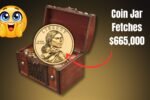The Lincoln Wheat Penny is a popular coin among collectors. It was first made in 1909 to honor the 100th birthday of Abraham Lincoln. This was the first U.S. coin to show a real person instead of a symbol like Liberty. The back of the coin has two wheat stalks, which is why it’s called the “Wheat Penny.” The design stayed until 1958, when it changed to the Lincoln Memorial.
Most of these pennies are only worth one cent. But some special ones are very rare and can be worth a lot of money. One even sold for about $960,000. This has made many people excited to search their old coins for hidden treasures.
Why Some Lincoln Wheat Pennies Are Valuable
Not all old pennies are worth a lot. But some have features that make them rare and valuable:
- Minting Mistakes: Some coins have errors like double prints or are made from the wrong metal.
- Low Number Made: Some years had fewer coins made, which makes them harder to find today.
- Good Condition: Pennies that were never used or kept in great shape are worth more.
- Special Traits: Some have missing mint marks or were made from unusual metals. A well-known example is the 1943 copper penny.
During World War II, the U.S. made pennies from steel to save copper. But a few copper ones were made by mistake. These rare 1943 copper pennies are worth hundreds of thousands of dollars.
List of Valuable Lincoln Wheat Pennies
Here are some of the most valuable types that collectors look for:
| Year & Type | Details | Value Range |
| 1909-S VDB | Has designer’s initials, very rare | $1,000 to $10,000+ |
| 1914-D | Low mintage from Denver | $2,000 to $20,000 |
| 1922 No D | Missing mint mark, rare error | $5,000 to $30,000+ |
| 1943 Copper | Made from copper by mistake | Up to $960,000 |
| 1955 Double Die Obverse | Letters and numbers are doubled | $1,500 to $10,000 |
These values depend on the coin’s condition and how rare it is.
How To Spot a Rare Wheat Penny
If you want to check your coins, here’s what to look for:
- Check the Year: Focus on coins made before 1959. Look for years like 1909, 1914, 1922, 1943, and 1955.
- Look at the Mint Mark: Under the date, you may see a letter. “D” means Denver, “S” means San Francisco, and no letter means Philadelphia.
- Search for Errors: Use a magnifying glass to find strange prints, off-center images, or missing letters.
- Do a Magnet Test: A 1943 steel penny sticks to a magnet, but the rare 1943 copper penny does not. Also, copper pennies weigh about 3.11 grams, while steel ones are lighter.
Can You Still Find Rare Wheat Pennies Today?
Yes, it’s still possible. While many rare coins are already found, some may still be in piggy banks or old boxes. Some people even get lucky with change from stores. That’s why collectors keep checking their coins.
What To Do If You Find a Rare Wheat Penny
If you think your penny is valuable, do these steps:
- Do Not Clean It: Cleaning the coin can lower its value.
- Get It Checked: Show it to a coin expert or trusted dealer.
- Do Some Research: Look online for prices of similar coins.
- Keep It Safe: Use a coin holder or case to protect it from damage.
FAQs
What is a Wheat Penny?
A U.S. penny made from 1909 to 1958 with wheat stalks on the back.
Is the 1943 copper penny rare?
Yes, only a few exist, and they are very valuable.
Should I clean an old penny?
No, cleaning can ruin its value.
Where is the mint mark on a Wheat Penny?
Below the date on the front of the coin.
Can I find rare pennies in my change?
Yes, it’s rare but possible.



